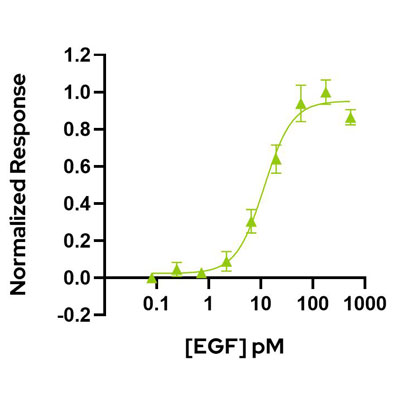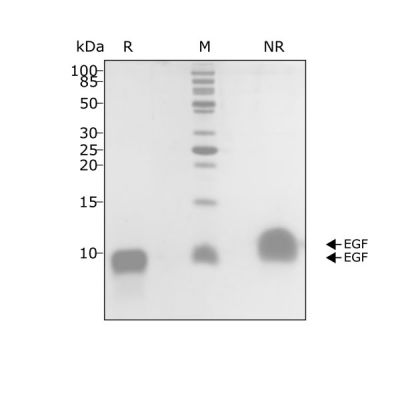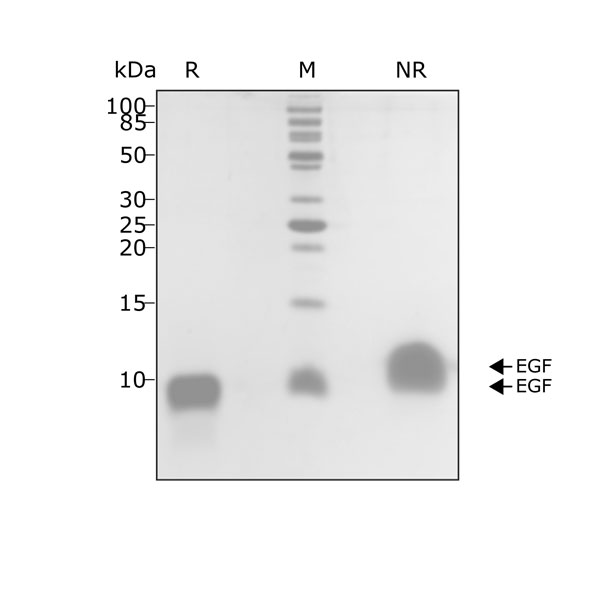Currency
Recombinant human EGF protein (Qk011)
Human epidermal growth factor (EGF) protein is a potent EGF-family growth factor used in many human and mouse organoid and stem cell culture systems including intestinal and tumor organoid culture. EGF is also used in epithelial cell culture.
Qkine human EGF (Qk011) is a highly pure, animal origin-free, bioactive 6.3kDa recombinant protein, making it ideal for use in chemically defined induced pluripotent stem cell (iPSC), embryonic stem cell (ESC) and organoid culture media.
Orders are typically shipped same or next day (except Friday).
Easy world-wide ordering, direct or through our distributors.
1000µg will be despatched as 2 x 500µg
Fast and free shipping.
Buy online with secure credit card or purchase order.
For any questions, please email orders@qkine.com
Summary
High purity human EGF protein (residues 971-1023, Uniprot: P01133)
>98%, by SDS-PAGE quantitative densitometry
6.3 kDa
Expressed in E. coli
Animal origin-free (AOF) and carrier protein-free
Manufactured in our Cambridge, UK laboratories
Lyophilized from acetonitrile, TFA
Resuspend in 10mM HCl at >100 µg/ml (provided with protein and free of charge), prepare single use aliquots, add carrier protein if desired and store frozen at -20°C or -80°C
Featured applications
Tumor organoid culture
Human
Species similarity:
Porcine – 85%
Mouse – 74%
Rat – 70%
Frequently used together
Bioactivity

EGF activity is determined using the Promega serum response element luciferase reporter assay (*) in transfected HEK293T cells. Cells are treated in triplicate with a serial dilution of EGF for 3 hours. Firefly luciferase activity is measured and normalized to the control Renilla luciferase activity. EC50 = 11.6 pM (72.8 pg/mL). Data from Qk011 lot #10. *Promega pGL4.33[luc2P/SRE/Hygro] #E1340
Purity

EGF protein migrates as a single band at ~12 kDa in non-reducing (NR) and 9 kDa in reducing (R) conditions. Purified recombinant protein (7 µg) was resolved using 15% w/v SDS-PAGE in reduced (+β-mercaptothanol, R) and non-reduced conditions (NR) and stained with Coomassie Brilliant Blue R250. Data from Qk011 lot #011.
Further quality assays
Mass spectrometry: single species with expected mass
Endotoxin: <0.005 EU/μg protein (below level of detection)
Recovery from stock vial: >95%
We are a company founded and run by scientists to provide a service and support innovation in stem cell biology and regenerative medicine. All our products are exceptionally high purity, with complete characterisation and bioactivity analysis on every lot.
Protein background
Members of the human epidermal growth factor family are synthesized as type I transmembrane precursor proteins, often containing several EGF domains in the extracellular region. Proteolysis yields mature proteins that are released from the cell surface [1]. Epidermal growth factor binds to high-affinity EGF receptors (EGFRs) and promotes receptor dimerization and clustering leading to activation of downstream signaling pathways, including PI3K, ERK1/2, JAK/STAT, β-catenin, and calcium signaling [2].
Human epidermal growth factor (EGF) stimulates cell proliferation and differentiation. It is used extensively in induced-pluripotent stem cell (iPSC) and embryonic stem cell (ESC) culture systems for the successful expansion and differentiation of epithelial, neural, mesoderm and hematopoietic lineages [3]. EGF also stimulates the differentiation of mesenchymal stem cells (MSC) into bone-forming cells [4].
Recombinant EGF protein is a key component of many organoid media, along with other stem cell niche factors, R-Spondin 1, Noggin or Gremlin, Wnt3a and FGF10. In addition, recombinant EGF is used for establishing and maintaining intestine, stomach, liver, pancreas, brain and cancer organoids [5].
Publications
Preprint. 2024
Metabolic rewiring underpins human trophoblast induction.
Authors: Jan Żylicz, Karlien van Nerum, Anne Wenzel, Lidia Argemi Muntadas, et al.
Lab: Jan Żylicz, University of Copenhagen, Denmark
FAQ
Epidermal growth factor (EGF) is a growth factor which stimulates cell proliferation and differentiation.
Originally found in salivary glands and urine, EGF is known to be expressed in many human tissues, including platelets.
EGF primarily stimulates growth of epidermal and epithelial cells, but is also used for expansion of stem cells in feeder-free culture systems.
Epidermal growth factor receptor (EGFR) family are receptor tyrosine kinase (RTK) proteins. There are 4 members: EGFR (ErbB1, HER1), ErbB2 (HER2), ErbB3 (HER3) and ErbB4 (HER4).
Tyrosine phosphorylation of EGF receptors stimulates various signaling pathways, including Ras/MAPK, PLCγ1/PKC, PI3 kinase/Akt, and STAT pathways.
EGF can be added to many stem cell cultures to maintain them in their pluripotent state.
Our products are for research use only and not for diagnostic or therapeutic use. Products are not for resale.




What others are saying
There are no contributions yet.